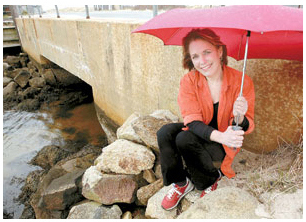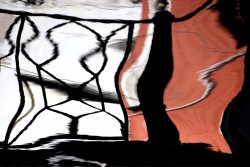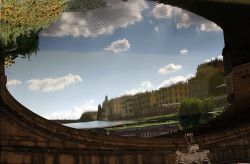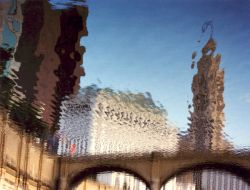
Jan, 16, 2007
Connecticut Post
The Sound of Photos
written by Brandie Jefferson
The Sound of Photos:
Artist shares her unique perception in Ridgefield photo exhibition
By Brandie M. Jefferson Associated Press

When Marcia Smilack goes down to the water near her home in West
Tisbury, Mass., to take photographs, it's important that there's
nothing on her mind. She looks straight ahead, walking along a pier on
Martha's Vineyard, until something in her peripheral vision also
stimulates her other senses. When she sees something, she also hears it
as, for example, chimes.
That's when she hits the shutter.
It may sound poetic, but taking a picture of the sound of chimes is
more than a metaphor for Smilack. She has a rare neurological condition
that makes it possible for her to take a picture such as "Furry Lights
and Chimes" that she feels and hears as well as sees.
It has led her to document life on Martha's Vineyard in photographs that only she perceives wholly, yet have a universal appeal.
The 57-year-old Columbus, Ohio, native is one of an unknown number of
people that have synesthesia — from the Greek words "syn" meaning union
and "aesthesis" meaning sensation.
Anina Rich, a researcher at Harvard's Visual Attention Laboratory who
did her doctoral thesis on synesthesia, said synesthetes
(sin-ess-TEETS) most commonly see letters and numbers in distinct
colors: 'A' is always red, for example, or '3' is brown, no matter what
color ink the characters are printed in.
Less common is linking several senses at once, as Smilack does. Her art
provides a sideways glance into a different way of perception.
Smilack says her photograph that best represents synesthesia is "Fish
in the Sky." Like all of her pictures, it's a reflection on the surface
of water. A boat is gently distorted on a partially cloudy day. To the
left of the mast, faintly visible behind the clouds, is a fish that was
swimming close to the surface when she caught the image.
Focus on the boat, and the fish is nearly impossible to see. Focus on
the fish, and the boat — which takes up most of the shot — somehow
becomes a peripheral image.
"The difference in making the fish the focus versus the boat is what
synesthesia feels like," Smilack said. Her secondary perceptions are
always available to her, but typically they don't take center stage.
Smilack has no formal photography training, she moved to the island
after she finished her doctoral degree in English literature. She had
been working on a book, but found herself distracted by the buoys
outside her window.
"The light hitting the buoys struck like a siren for me," she said, and
she decided to photograph them. "I just couldn't resist. I never
finished the book."
She currently has an exhibit at The Enchanted Garden Conservatory of
Arts in Ridgefield, Conn., where a six-foot print of "Fish in the Sky"
is on display. And a Japanese film crew visited the Martha's Vineyard
to include Smilack in a two-hour television documentary that aired at
the end of last year.
Most of her photographs are reflections of large, rigid structures —
boats, bridges, cityscapes — taken on the surface of calm waters. In
some cases, the distorted effect is indistinguishable from broad
paintbrush strokes.
"On water, things look much more like the way things feel," Smilack
said, glancing sideways. Any given image exists just for a moment.
Viewed from a different angle, it disappears.
When she drives down the winding street in West Tisbury that leads to
her house, Smilack sees more than the road ahead. Hovering somewhere
between her left peripheral vision and the outside world, shapes morph
in and out of each other, dancing in three dimensions. But if she tries
to look directly at them, she said — poof! — they're gone.
"I'm watching the sound of my voice, the sound of the car," she
explained. But not to worry, she said assuredly, the shapes don't get
in the way.
Most people with synesthesia would never call it a disorder.
"That would implicate that there is some problem, some disability that
you are facing," said Sean Day, president of the American Synesthesia
Association and a friend of Smilack's.
"There can be unpleasant moments" — like the time he fell out of his
seat when the colors he saw after hearing a theremin, an electronic
musical instrument, caught him off guard. "But in general, it's not a
problem."
Synesthesia is such an integral part of her life, Smilack said — almost
banal — that it never came up with her immediate family. After all,
"would you ever talk about breathing?" she asked.
She is convinced that most people understand the synesthetic associations, even if they can't experience them.
"Why do people talk about sharp cheddar cheese or loud colors? What
ends up in the language expresses some fundamental truth about people,"
she said. "You know exactly what it means, but why?"
Smilack thinks there's something very basic about synesthesia. Maybe
her brain has vestigial connections that allow, for instance, visual
inputs to be processed as sounds.
One popular theory of the condition is that people with synesthesia
have extra neural connections in their brains that most people were
born with but lose over time. Another theory suggests most adults have
sufficient connections, but only certain people are able to use them.
Her perceptions don't distract her, Smilack said.
In fact, she thinks her world is more open and balanced than for people
without the condition. For most people, there is a brick wall between
consciousness and the information that hits the eyes or rattles the
ears, but doesn't quite make it to perception. The information is
available to her at all times, in the periphery of perception.
"Consciousness," she said, "is just a curtain for a synesthete."
This difference in perception has caught the attention of scientists
around the world who think that understanding the exceptions may help
explain the norm.
"It's a fascinating thing that happens to a minority of the
population," Rich said, but for the majority of people, still, "you're
talking, integrating the visual with the auditory input, all
effortlessly.
"How is it that we get this cohesive view of the world when we're processing in different parts of the brain?" Rich said.
In one study of 150 self-reported synesthetes, Rich and her co-authors
found that over three months, those who said they were synesthetic
reported the same color for a particular letter with an 87 percent
consistency. The control group had only 26 percent consistency after
just one month.
The study also used functional magnetic resonance imaging to monitor
blood flow in the brains of people who experience colored letters and
found they had unique activity in regions involved in processing visual
information when the control subjects did not.
Smilack has been in contact with researchers around the world. She has
been surprised by the parallels they find between her art and their
research, comparing, for instance, pictures of sounds to sine waves
created by vibrating strings.
One researcher asked Smilack if she was offended by his attempts to discuss her art in the cold, clinical terms of physiology.
Smilack, who is working with scientists to create visual aides for the
blind, and has made herself the subject of much questioning, said she
thinks it's all related.
"The physiological process," she said, "complements the art."













